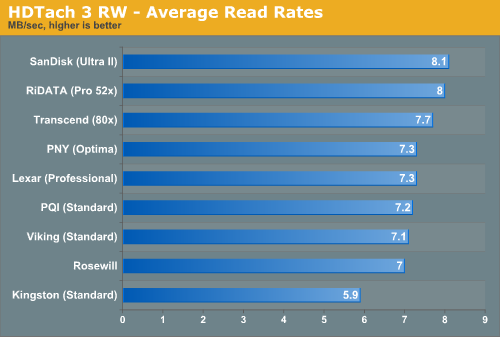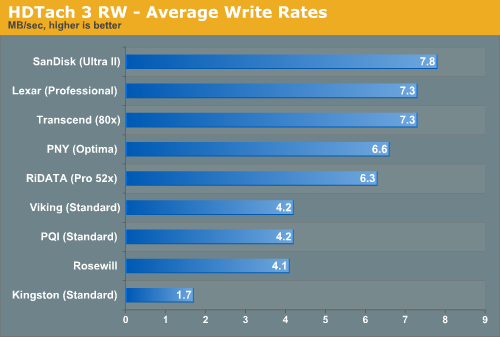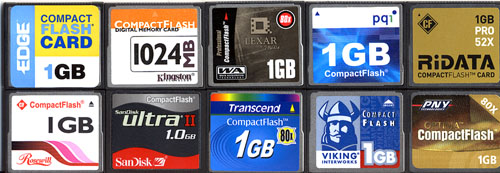
Original Link: https://www.anandtech.com/show/1906
Flash Media: 1GB CompactFlash Roundup
by Purav Sanghani on December 23, 2005 12:05 AM EST- Posted in
- Storage
Introduction
The demand for flash media has grown astronomically over the last few years as more digital devices such as personal digital music players, personal digital assistants, and digital cameras have gone main stream, and we're only going to see the demand for higher capacities and speeds to complement the quickly advancing technologies such as professional digital cameras and personal entertainment devices.
One of the most common types of flash media is the CompactFlash digital media, which is based on the same ATA standard as on hard disk drives. CompactFlash media was the first to provide high capacities and keeps its track record by providing up to 8GB of solid state memory (by the time that this article will be published). The transfer rates of CompactFlash media have also increased over the years from the 1x, 150KB/sec standard cards to the current maximum of 16MB/sec rates. Also, the CFA ( CompactFlash Association) released (just under a year ago) revision 3.0 of the CompactFlash Specification Revision to increase the interface transfer rates to 66MB/sec.
There is an abundance of brands, capacities, and speeds of CompactFlash media in the market today, which range in price between $15-$800 (256MB-8GB), but our focus for this roundup will be currently the most widely used capacity of 1GB. We have put together a list of brands both well known in the memory and flash media industry as well as some that many of us are seeing for the first time. Take a look at our competitors below.
| Model | Part No. | Price | |
| EDGE | Standard | PE188993 | $59.77 |
| Kingston | Standard | CF/1024 | $49.99 |
| Lexar | Professional (80x) | - | $87.59 |
| PNY | Optima (80x) | - | $85.72 |
| PQI | Standard | AC16-1030 | $60.81 |
| RiData | Pro 52x | - | ~$56 |
| Rosewill | - | RCF1024 | $51.99 |
| SanDisk | Ultra II | SDCFH-1024 | $73.95 |
| Transcend | 80x | TS1GCF80 | $65.95 |
| Viking | Standard | CF1GB | $53.99 |
All of these cards are standard CompactFlash Type I media cards with varying speeds with exception of the Lexar Professional series media, which features its "Write Acceleration Technology", said to improve image write speeds by up to 23% with compatible cameras. This is done with the aid of special firmware on the media as well as the cameras themselves, which allow them to work together to improve the write algorithms. However, we have also seen an improvement in write speeds in our benchmarks as well, but we'll let you see for yourself.
Special thanks to NewEgg for providing us with the CompactFlash cards for this review.
The Test
To benchmark on our selected CompactFlash media, we picked up a Sabrent SBT-CRW4242-in-1 flash media reader that has an external USB 2.0 interface. Take a look at the test bed below.
Our test bed:
AMD Athlon 64 3500+ (2.2Ghz)
Giga-byte GA-K8NXP-SLI
Western Digital WD1600JS
NVIDIA 6600GT SLI Edition (single 128MB card )
1GB (512MBx2) Corsair XMS4400
Sabrent SBT-CRW42 42-in-1 reader (Integrated Circuit Solutions, Inc. based hardware)
Our motherboard is an nForce4 based board, which features support for the SATA II standard, up to 3.0 Gb/sec SATA transfer rates, NCQ and TCQ , and the USB 2.0 standard for up to 480Mb/sec transfer rates.
We used the following NVIDIA platform drivers in conjunction with our test bed:
nForce4 Chipset Driver 6.82
NVIDIA graphics driver 81.95
Windows XP SP2 w/out further updates
| AnandTech Flash Media Tests | |
| Real World File System Task Tests | timed tests of copying files to and from flash media |
| HDTach 3 RW | Synthetic test to measure average read and write rates of flash media |
| SiSoft Sandra | Removable Storage/Flash Media Benchmark |
*Each card is formatted for the FAT32 file system using the default cluster size, since the majority of devices only support this file system.
Real World File System Tasks
Most users of flash media store smaller files like MP3s, pictures, and documents, which rarely exceed 10MB, so it made the most sense to test the media using 1MB, 5MB, and 10MB files. We measure the time that it takes to copy each file size to the media. Take a look at our results below.

HDTach 3 RW
HDTach 3 RW provides us with information regarding the average read and write rates for each media.


SiSoft Sandra File System Benchmark
SiSoft Sandra does things a little different than HDTach 3 RW. The results reported here refer to the number of operations per minute while working with the various sizes of chunks of data. The final "Combined Index" value refers to the "combined performance in terms of Combined Operations Per Second, with respect to a mix of write, read and delete operations" across all of the tested file sizes.
The number we see for the "Endurance Factor" represents the overall "Wear and Life Expectancy" of the flash media. The fact of the matter is that flash media can be written to only so many times. Upon each write, some amount of wear occurs which cause performance degradation and eventually, though not so quickly, failure of the media. SiSoft Sandra calculates the "Endurance Factor" by dividing the average performance, for example a sequential write, by the lowest performance, a rewrite of the same block of data initially written to. For all of the values, high is always better.
| SiSoft Sandra Removable Storage/Flash Benchmark Operations per second |
|||||||
| 512B | 32KB | 256KB | 2MB | 64MB | Combined Index | Endurance Factor | |
| EDGE | 1885 | 1659 | 866 | 161 | 6 | 1509 | 14.0 |
| Kingston | 351 | 331 | 242 | 33 | 2 | 299 | 38.2 |
| Lexar | 4699 | 3853 | 1355 | 194 | 7 | 3543 | 7.6 |
| PNY | 650 | 613 | 464 | 71 | 5 | 556 | 19.3 |
| PQI | 240 | 230 | 197 | 78 | 3 | 215 | 42.7 |
| RiData | 1080 | 1000 | 676 | 87 | 6 | 903 | 32.4 |
| Rosewill | 240 | 231 | 200 | 79 | 3 | 216 | 43.3 |
| SanDisk | 470 | 439 | 349 | 94 | 7 | 407 | 43.5 |
| Transcend | 1588 | 1428 | 849 | 127 | 7 | 1296 | 8.9 |
| Viking | 245 | 236 | 206 | 81 | 3 | 221 | 45.0 |
As far as performance goes, Lexar's Professional series CompactFlash media takes the gold with its combined index of 3543 operations per minute but its overall life expectancy is not much to drool about. The values should be compared not to any outside standard but only to the other media on this list and it looks like Viking's standard CompactFlash model is going to outlive the rest of these devices. In fact, none of the top performers look like they will live as long as the lower performing cards. We assume this is because the high performance products perform a lot more read, write, and erase operations on average compared to the lower end cards. It is a simple trade-off between performance and life expectancy.
Final Words
Lexar's "Write Acceleration Technology" seems to have extended its performance past the supported digital cameras to our desktop flash memory card reader, while the Professional series card has performed the quickest out of 10 cards in the Real World test. However, SanDisk has also proven itself a worthy product by topping the HDTach charts in sequential read and write performance.
We, of course, knew that we'd be comparing apples to oranges by throwing 1x cards together with the higher performance 80x cards, so let's break them down by their manufacturer's specifications, real measured performance, and price.
| Manufacturer's Specified Performance | Actual Performance | Price | |
| Lexar | High | High | $87.59 |
| PNY | High | Mid | $85.72 |
| Transcend | High | High | $65.95 |
| EDGE | Mid | Mid-High | $59.77 |
| RiData | Mid | Mid | ~$56 |
| Rosewill | Mid | Mid | $51.99 |
| SanDisk | Mid | Mid-High | $73.95 |
| Kingston | Low | Low | $49.99 |
| PQI | Low | Mid | $60.81 |
| Viking | Low | Mid | $53.99 |
After taking into consideration the selling price of each product, Transcend's 80x model provides enough performance to make it the first choice of high performance CompactFlash media. It comes second only to Lexar's flash card, but it is priced more than $20 lower. For the mid-performance cards, the EDGE brand CompactFlash media takes the gold as it performs the best out of the batch and is also competitively priced at about $60. For the lower end cards, the PQI model is priced a bit too high for the performance that it puts out. Viking's standard model gives us decent low end performance at a viable price of $53.99, which makes it a top "low-performance" pick.
There is, of course, a very large number of CompactFlash cards out there, which can fit into these categories. Unfortunately, we did not have a chance to look at them, so it's best to try a few different cards out before you settle for a single brand and model. Prices are also always changing due to supply and demand of flash memory chips. Therefore, it is very possible that Lexar's high performance card can catch up with Transcend and give it a run for its money.
Our overall pick would have to be Transcend's 80x card as it is priced at about $66; only $5 over the mid-performance EDGE card and just over $10 above our low performance Viking pick.
Special thanks to NewEgg for providing us with the CompactFlash cards for this review.








